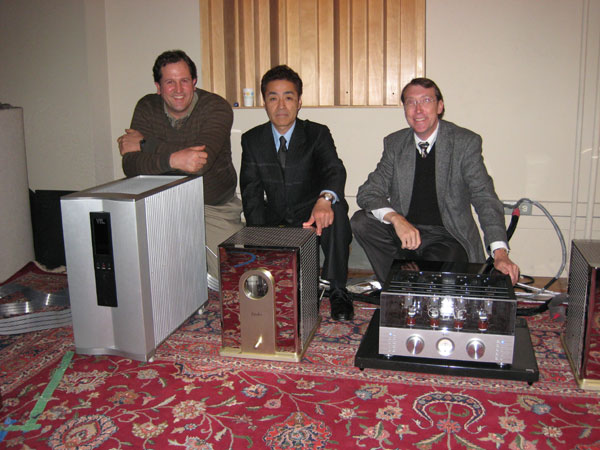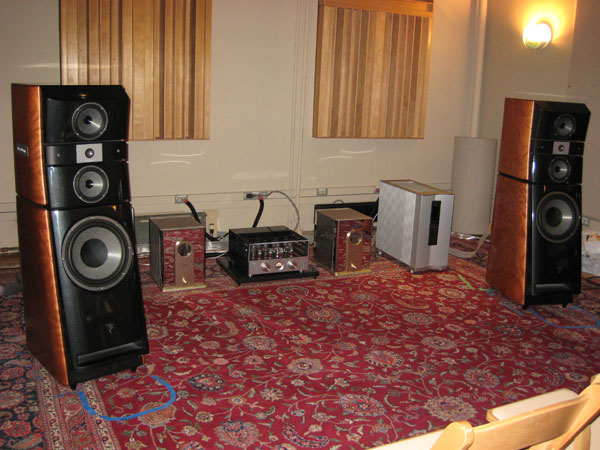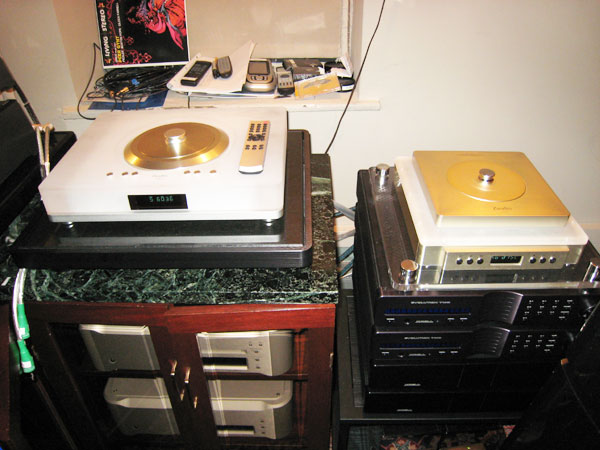![[SoundStage!]](../sslogo3.gif) Config.Sys Config.SysBack-Issue Article |
|||
August 2008 Tubes 3, Solid State 1
Tubes were the topic du jour at a Sound by Singer seminar held in the heart of Manhattan, where I found myself surrounded by some of the foremost bottleheads in the business willing to share their thoughts on their favorite audio devices. The distinguished presenters included Kevin Hayes, CEO of Valve Amplification Company (VAC); Luke Manley, president of Vacuum Tube Logic (VTL); and Kazutoshi Yamada , president and CEO of Zanden Audio Systems. The idea here was to have a demonstration of some of the best tube gear extant in groupings by manufacturer along with a discussion between the gurus and the seminar attendees. While I have nothing but chips in my system, I was at this seminar because I am completely open to the idea of having tubes somewhere in my system, and I probably will at some point. I used to think that buying a piece of audio equipment that slowly deteriorates and burns out over time was a fairly silly concept, but I just purchased a big honkin’ plasma TV for the family room, so I guess silly is as silly does. Suffice it to say, I was part of a very interested audience.
The tasty system used to show off all this beautiful tubular hardware included Focal-JMlab Nova Utopia Be speakers, a DCS digital stack, a Brinkmann Balance turntable, and Nordost Odin speaker cables and interconnects. The room itself was fairly large (especially by New York City standards) with the only issue being a bothersome PA system that kept butting in intermittently. (Hey, it’s a high-end stereo shop -- couldn’t somebody figure out how to turn that thing off?) Fortunately there was enough time between announcements to get a nice exposure to all the delicious tube equipment on hand.
Speaking of which, the formidable tube wares on sonic display were a VAC Phi 300.1 stereo/mono amplifier ($18,000) and Phi Beta triode preamplifier with phono ($18,500); a VTL TL-7.5 Reference II line-stage preamplifier ($16,500), a pair of Siegfried mono power amplifiers ($40,000), and a TP-6.5 phono stage ($8500); a Zanden Model 1200 Mk 2 phono stage ($19,250), a Model 3000 line-stage preamp ($16,470), a pair of Model 9500 mono power amplifiers ($42,970), a Model 2500S CD player ($20,970), a Model 5000 Signature DAC ($17,570) and Model 2000 Premium transport ($28,970). About $230,000 in all. Trio in stereo As I walked into the room, Kevin Hayes already had his amps plugged in and playing. This was all gear I was unfamiliar with in a room I’d never been in, so at this point relative sound appraisals were out the door. But I will say that I was impressed immediately by the naturalness and flow of the music (which, by the way, I was also unfamiliar with). Nothing stood out or called attention to itself across the frequency spectrum; the sound was very linear and balanced across the board, while the soundstage was vast and well delineated left to right and front to back. The Focal speakers did a nice job of unleashing the music into the room while still managing to hide their considerable bulk. The only thing I noted was a slight sheen to vocals that I did not expect to hear with this level of equipment, and especially with tubes, so I made a mental note as the others took their respective turns. Next up was Luke Manley with his large, server-like Siegfried amps and '7.5 preamp. He was operating the amps, which use a dozen 6550s or KT88s per side, in tetrode mode, yielding a whopping 800W as opposed to "only" 400W operating in triode. The sound was slightly more detailed and focused than with the VAC gear, and the bass was clearly deeper and tighter -- the speakers apparently appreciated the extra bottled juice. Another excellent yet different presentation for sure, and I’d bet if you put a hundred audiophiles in the room, half would prefer the VAC and the other half the VTL system. Both sounded good enough that there clearly was no right or wrong here, just a different perspective. The soundstage again was large and unfettered, but that sheen I mentioned earlier was still present. OK, so we’ve pretty much ruled out the amps and preamps as the culprits, which was good to know. I did get to play one of my reference CDs, and I chose Tony Falanga’s Soul of the Bass [plane 88846] because it’s full of tone, nuance, and spatial cues within a large recorded space. Unfortunately I only got to hear "Lament" as time was lamentably short, but as expected the double bass sounded physically present and in full tonal splendor. The "room within a room" feel was also there, but some smaller details, such as fingers scraping on strings, were more obscure relative to what I hear on my all-solid-state system in my much smaller room. The other notable issue was that, as the bass plumbed its depths, the image appeared to bloom to the point of losing focus and control (or maybe I’m just too used to that crappy solid-state bass -- more on that later). Whether this was a function of the speakers, the amps, an interaction with the room, or perhaps something else -- or a combination of everything -- is impossible to say. Given that this occurred with the VTL amps, which clearly had the tightest bass of the group, I can only assume that things would have been no better with either the VAC or Zanden gear. Lest we get caught up in the details here, let me say that the presentation as a whole was very believable and involving, despite these issues. Last up was the Zanden equipment. Again, relative to the VTL, the Zanden sounded a touch smoother and rounded with less tight-fisted control -- much more like the VAC presentation to my ears. There was a liquid musical flow about the Zanden sound that was very relaxing and inviting, and there was very much of a "detail in service of the music" kind of feel. An interesting wrinkle during the Zanden presentation was the comparison of the relatively new Model 2500S CD player versus the highly regarded Model 5000 Signature/Model 2000 Premium DAC/transport combo that so many reviewers use as a benchmark for digital reproduction. Apparently, at a previous show some attendees remarked about some significant shortcomings they had heard in the Model 2500S, so Yamada-san went back to work and incorporated more of the Model 5000’s parts and circuitry in an effort to recapture some of the missing, um, Zanden-ness. Although the separates exhibited a little smoother and more open sound that, relatively speaking, made the 2500S sound just a touch more granular, the overall big-picture presentation showed a lot of similarities. And at about half the price of the separates, my thought was you get much more than half the way to what the separates offer -- about 90% or so by my calculator. So while at over 20 large the 2500S sure ain’t cheap, if you lust after the Zanden separates but can’t pony up that level of dough, the new CD player may well buy you enough Zanden-ness. Interspersed with the demos were some very informal discussions about tubes and the designers’ various beliefs and approaches to building tube gear. When asked why he's committed to tubes, Kevin Hayes submitted that they are more linear and make music "come to life with more veracity" and in a way he just doesn’t hear with solid-state gear. In fact, he went so far as to say that solid state makes him not want to listen to music. Kevin is nothing if not clear and to the point. Luke Manley concurred and added that with the linear voltage you get with tubes, as opposed to current delivered by transistors, there is not as much need to employ error correction or feedback into the design. It was also brought up that speakers tend to like a constant voltage source that tubes do well but that can create difficulties for solid-state amplification. Yamada-san chimed in that, in addition to the characteristics previously mentioned, tubes avoid switching noise and that, in general, he strives to make the circuit as simple as possible in his designs. This all made sense and sounded good to a wafer boy like me. I might really have to try me some of these tube thingies in my system sooner rather than later. Although they agreed on much regarding the benefit and use of tubes in audio applications, Kevin and Luke participated in a lively discussion regarding active regulation. Kevin stated he heard clear benefits in avoiding active regulation and has gone to great lengths to avoid incorporating it into his designs, while Luke maintained that, if implemented correctly, an amplifier can still sound terrific with active regulation. Yamada-san stated that he uses a tube rectifier in his amplifiers. Although they agreed to disagree on this point, all the designers were unified in their belief that tubes were a superior way to reproduce believable music, and that all that matters is not how something is designed but what it sounds like in the end. To which I will add, "Amen." I was a bit surprised that the trio took on the subject of bass so readily, as this is not traditionally thought of as an area of natural strength for tubes, and it is where the current capabilities of solid-state amplification would seem to reign supreme. But all three designers were in agreement that tube bass was superior. Luke found the solid-state amps to have a lot of whack but that they fail to reproduce the considerable tonal color that exists within the bass range. Kevin, again not one to mince words, just said outright that tubes have better bass. I will say that, through its bloat and bloom, the aforementioned Falanga double bass did have gobs of tone that I don’t hear in my room. Of course, the additional tone could have come from anywhere in the system’s chain, but there could very well be something to this contention, although I’ll need to hear it firsthand in my own room before I fully believe it. Old mantras die hard, you know, and there is that nagging element of control. What’s next -- chip-based designers declaring they rule the realm of tone and timbre? Talkin' sound At this point the discussion began. Technical in nature while sounding quite interesting, it would have required a few electrical-engineering classes for me to even pretend to begin to understand. During a lull, I took the opportunity to bring the conversation over to the dark side and down to my level by asking simply if there was any solid-state equipment out there that they really liked or were intrigued by. There was a little pause -- understandable because this was a tube-based seminar -- and I could almost see them asking themselves, "Are you serious?" To the brainiacs’ credit they shared some thoughts on the subject, but to a man they personified chewing on tinfoil. I didn’t get one firm answer on a solid-state component they really liked, but as for the intrigued part, there were some entries. Kevin Hayes expressed some interest in the higher-powered McCormack designs. That stung a little because I own a DNA 0.5 Rev. A, which is probably the lowest-powered amp McCormack produced, at least when I was amp shopping. He also had some interest in the Bryston designs. For Luke Manley’s part, he was intrigued by the latest Krell Evolution line and products from Conrad-Johnson (parent company of McCormack, so we did have a little theme going here) and Electrocompaniet. I wasn’t too surprised by the C-J and Electrocompaniet choices, as they could be seen as tending toward the softer, smoother side of solid state, but one of the last names I would have expected to hear out of this bunch would be Krell. I have a feeling, however, that the interest was more of a technical nature centered around the CAST and/or Current Tunnel technologies rather than overall sound. Speaking of overall sound, the question arose on what speakers the designers use to evaluate their new products during development and for final voicing. Luke Manley stated that he primarily uses Wilson Audio MAXX 2 speakers, which seem like a mighty fine choice if you’re gonna use just one. Kevin Hayes, on the other hand, uses a variety of speakers during the development process to get a broad perspective on how a given component will fare under a variety of loads and interpretations. His rationale is that when you find a change that is apparent and consistent in all the speakers, you know you’re onto something. Yamada-san seemed to agree with this approach, as he uses B&W 801D, Ascendo, and Quad 908 speakers to evaluate his designs. I think there is a lot of sound logic in the multi-speaker theory, and it certainly makes good common sense, but I would also think it could drive you nuts trying to please all comers. It’s almost like being a politician, and who the hell wants that job? Hey, as a consumer I say whatever works is best. Hayes followed with a point on the design process, proclaiming that he never completely abandons "old technologies" because new technology can sometimes come around to breathe new life into them. As someone who never throws anything away, I could certainly appreciate that. He also threw in a quick anecdote, saying that diodes, the predecessors of transistors, appeared in the 1800s and actually predate tubes, which didn’t make the scene until the early 1900s. So putting two and two together, maybe we should expect a new product from Kevin incorporating diodes and tubes? One of the attendees asked what the presenters felt was the best way to build a system. Luke Manley submitted it’s best to start with speakers and find the amp that will drive them. He also said that building a system is like painting the Golden Gate Bridge -- the inference being that once you think you’re done, the part you started with needs attention all over again. That got a bit of a chuckle, as I think everyone in the room could relate intimately (and financially) with that colorful metaphor. It’s the audiophile’s vicious circle. The debate continues So at the end of the day, I found the passion and reason of these three wise men to be both compelling and infectious, and what I heard out of that system certainly served to reinforce their words and justified their degree of dedication to the tube cause. Their specific methods may differ, but in the end they were all about the sound and were steadfastly unanimous in their belief and experience that tubes re-create a more realistic musical experience and the emotional attachment to it better than solid state. Maybe Sound by Singer will put on a solid-state seminar in the future and we’ll hear the flip side. The question is, Will the sound be as good? ...Tim Shea |
|||
|
|||
![[SoundStage!]](../sslogo3.gif) All Contents All ContentsCopyright © 2008 SoundStage! All Rights Reserved |


